Your cart is currently empty!
Types of Materials Used in Outdoor Area Rugs: Durability Meets Design

Outdoor area rugs are essential for creating comfortable and stylish outdoor living spaces. These rugs are designed to withstand elements like sun exposure, rain, and foot traffic, which makes their material composition crucial for durability and longevity. Materials such as polypropylene, polyester, and nylon are commonly used for synthetic outdoor rugs, offering a blend of strength, moisture resistance, and comfort. In contrast, natural fibers like bamboo can also be used, bestowing a unique aesthetic but often requiring more care to maintain their condition.
When choosing an outdoor area rug, it’s important to consider the specific conditions and features of the space where the rug will be placed. For instance, a rug under an outdoor dining table should be large enough to accommodate all chairs when pulled out, and ideally be made of a stain-resistant material to handle spills. Moreover, the color vibrancy and patterns of the rug material should complement the outdoor décor while the material itself should resist fading in sunlight.
Key Takeaways
- Outdoor rugs must be durable to endure weather and wear.
- Material choice depends on location, usage, and styling needs.
- Proper sizing and maintenance extend the life of outdoor rugs.
Understanding Outdoor Rug Materials
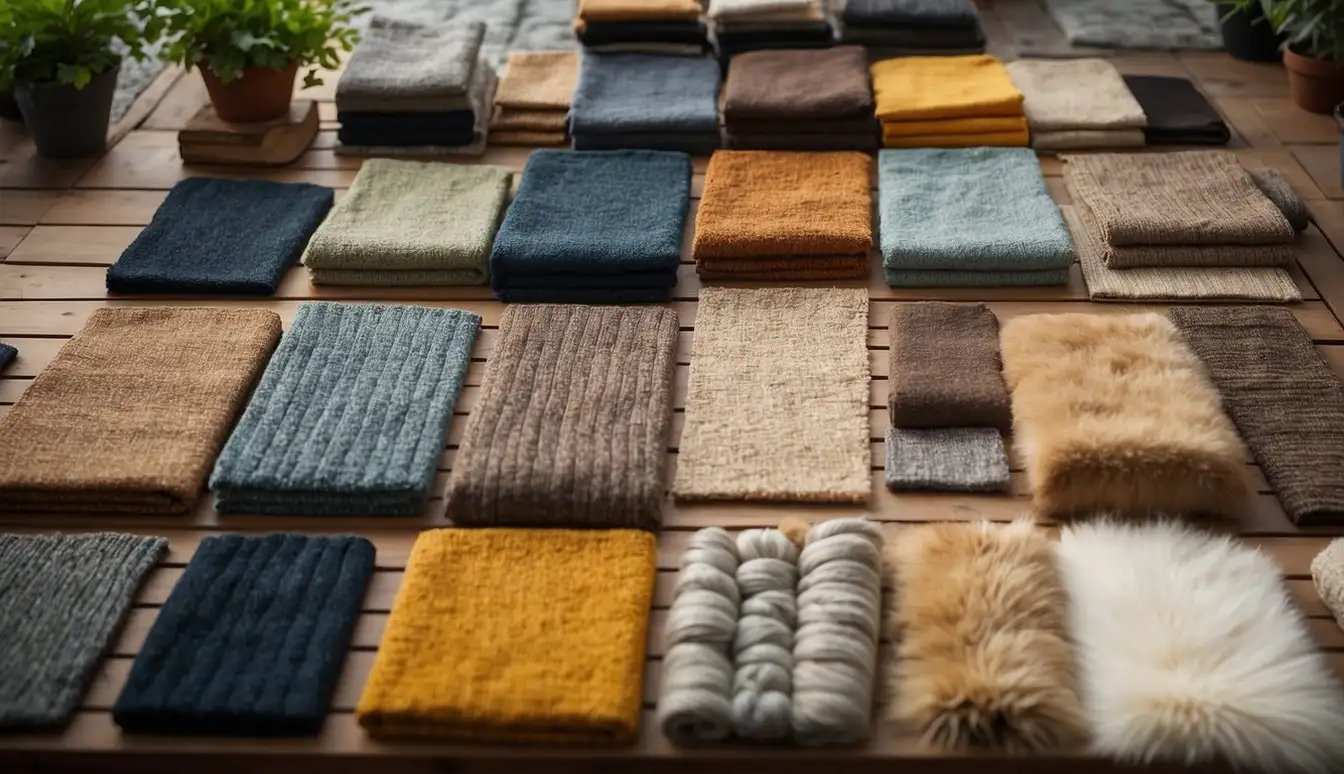
When selecting outdoor rugs, it’s crucial to understand the two main material categories: Natural Fibers and Synthetic Fibers. Each offers distinct advantages depending on your outdoor space’s requirements, such as durability and weather resistance.
Natural Fibers
Natural fibers, which I find to be both eco-friendly and aesthetically pleasing, include jute, cotton, sisal, seagrass, wool, and bamboo. These materials blend seamlessly with outdoor environments due to their earthy tones and textures.
- Jute: Great for covered areas, it provides a soft feel underfoot but can be less durable in damp conditions.
- Cotton: Often used as an accent or in blends, cotton provides comfort but may not be as resilient as other natural options.
- Sisal: This sturdy material offers a coarser texture, suitable for high-traffic areas; however, it can deteriorate if exposed to excess moisture.
- Seagrass: Known for its durability, seagrass rugs hold up well and offer a unique feel, yet they’re not as soft as other fibers.
- Wool: Although luxurious and naturally stain-resistant, wool rugs are better suited for covered outdoor spaces to preserve their longevity.
- Bamboo: As a rapidly renewable resource, bamboo rugs offer durability and are often used in roll-up style rugs.
Synthetic Fibers
Synthetic fibers like polyester, nylon, polypropylene (also known as olefin), acrylic, and recycled plastic dominate the outdoor rug scene for their exceptional durability and resistance to the elements.
- Polyester: It excels in fade and stain resistance, making it ideal for sunny and occasionally damp environments.
- Nylon: I’ve seen nylon used in heavier rugs that demand elasticity and strength. It can be blended with olefin to offer a balance of softness and weatherproof qualities.
- Polypropylene: This is perhaps most popular for its moisture and stain resistance. It’s an excellent choice for poolside or rainy climates.
- Acrylic: For an appearance that mimics wool with improved weather resistance, acrylic is a solid choice.
- Recycled Plastic: Rugs made from recycled plastic are eco-conscious choices that are typically mold and fade resistant, perfect for high-moisture areas.
By understanding the characteristics of these materials, I can make an informed decision that balances aesthetics, comfort, and practicality for my outdoor living space.
Properties of Outdoor Rug Materials
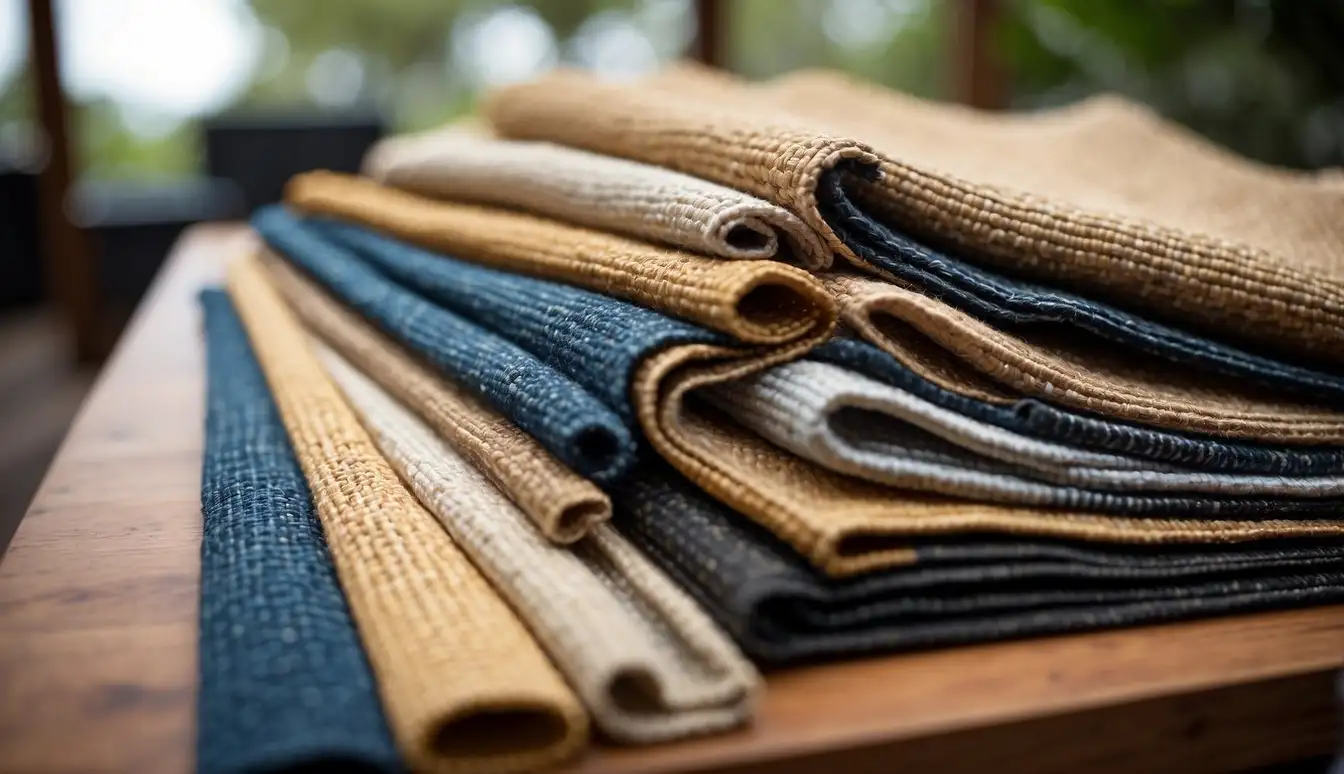
In my experience, outdoor rugs have to be tough to resist various elements and frequent use. Let’s take a closer look at the specifics that make materials fit for the outdoors.
Durability Factors
- Resistance to Elements: Synthetic fibers like polypropylene and polyester are champions when it comes to enduring harsh weather conditions. They don’t succumb easily to fading in the sun or breakdown from constant moisture exposure.
- Mold and Mildew Resistance: Outdoor rugs should resist mold and mildew growth. Thankfully, materials such as polypropylene are naturally resistant to these pesky fungi.
- Traffic Endurance: For those high-traffic areas on your patio or deck, you want a material that can take a beating without looking worn out. Nylon, woven with olefin, is known for its elasticity and longevity, handling foot traffic with ease.
Maintenance and Cleaning
- Routine Care: Synthetic rugs can typically be kept clean with regular vacuuming and an occasional shake to dislodge dirt.
- Deep Cleaning: When it’s time for a more thorough wash, most synthetic outdoor rugs can be sprayed down with a hose. For tougher stains, spot cleaning with a rug cleaner or a mild bleach solution can be very effective.
- Natural Solutions: If you prefer more eco-friendly cleaning options, baking soda can be used on many outdoor rugs to help lift stains and neutralize odors.
- Ease of Cleaning: Materials like polyester are inherently stain-resistant and easy to clean, which means less hassle for me when I’m sprucing up my outdoor space.
Design and Style Considerations
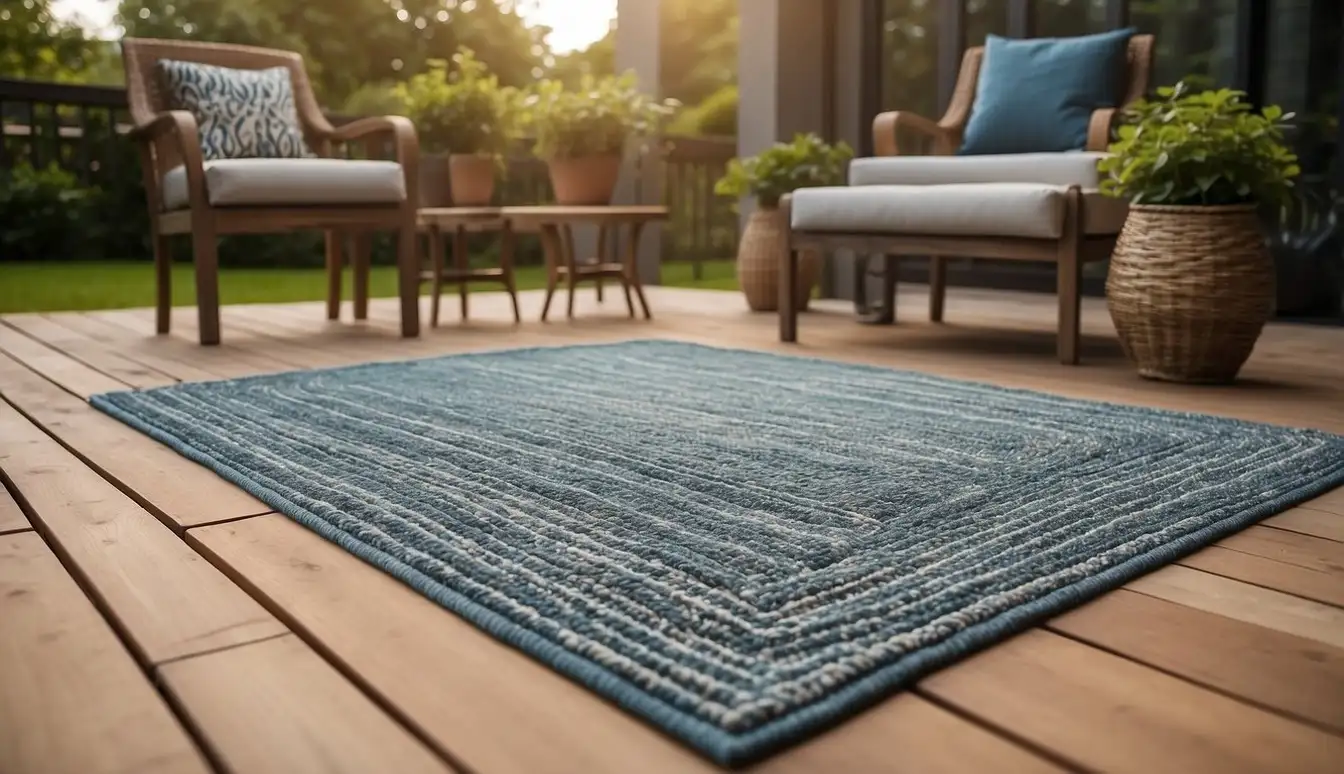
When I select an outdoor rug, my primary focus is on how its design and style will complement my outdoor living space. The patterns and colors, along with shapes and sizes, play pivotal roles in achieving the desired ambiance and functionality.
Patterns and Colors
I always consider the existing decor when choosing patterns and colors for an outdoor rug. For a harmonious look, I might select patterns that echo the shapes in my furniture or colors that match the accent tones in my cushions. Here’s an approach I use:
- Solid Colors: Ideal for a minimalist style or to let other decor elements stand out.
- Neutral Tones: They blend easily with any outdoor setting.
- Vibrant Patterns: Perfect for adding a focal point or energizing a space.
Shapes and Sizes
The shape and size of the rug must be proportional to the area I’m accentuating. Here’s how I think about it:
| Shape | Ideal Use |
|---|---|
| Rectangle | Dining areas or as an anchor for a seating arrangement |
| Round | Underneath a round patio table or to define a gathering spot |
| Square | To complement square furniture or a compact balcony |
I make sure to measure my space before deciding, ensuring my rug is neither too small nor overwhelmingly large.
Practical Considerations for Outdoor Rugs
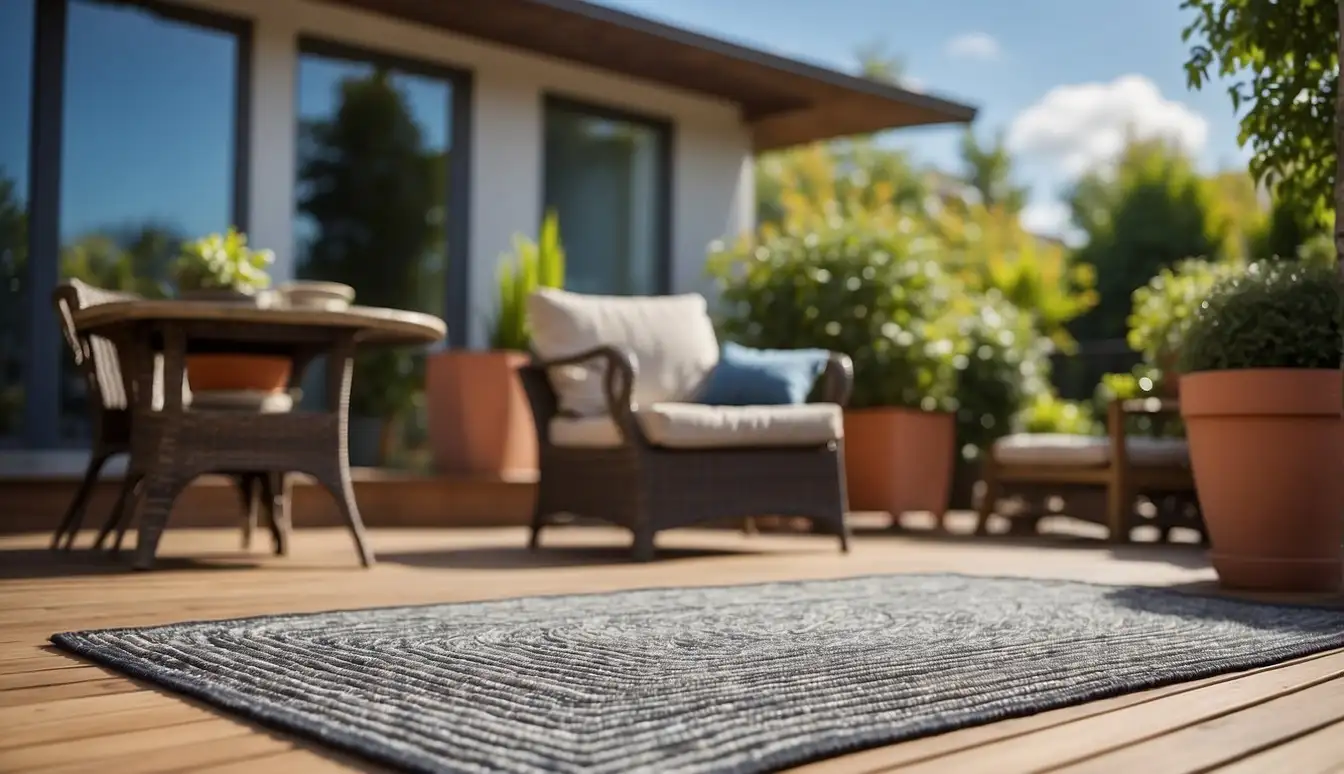
When choosing an outdoor rug, I always pay close attention to how the material will affect the rug’s comfort and how it will stand up to environmental elements.
Comfort and Texture
When it comes to comfort, the texture of an outdoor rug is paramount. I often look for synthetic fibers such as polypropylene or polyester because they offer a balance between softness and durability. These materials can also be surprisingly plush, making them a comfortable option for bare feet. However, rugs made from natural fibers may provide a more luxurious texture, even though they may not be as soft and can be thin. Durability doesn’t have to come at the expense of comfort, provided the right material is chosen.
Environmental Resilience
An outdoor rug must withstand the harshness of outdoor spaces. Synthetic fiber rugs like polypropylene are excellent for resisting mold, mildew, moisture, and dirt, making them highly water-resistant and weatherproof. Nylon, another synthetic option, can endure heavy foot traffic and direct sunlight without significant fading. On the contrary, natural fibers may offer less resistance to the elements but can be environmentally friendly and complement an outdoor aesthetic beautifully. The key is to select a rug that maintains its integrity through varied weather conditions.
Placement and Area-Specific Features
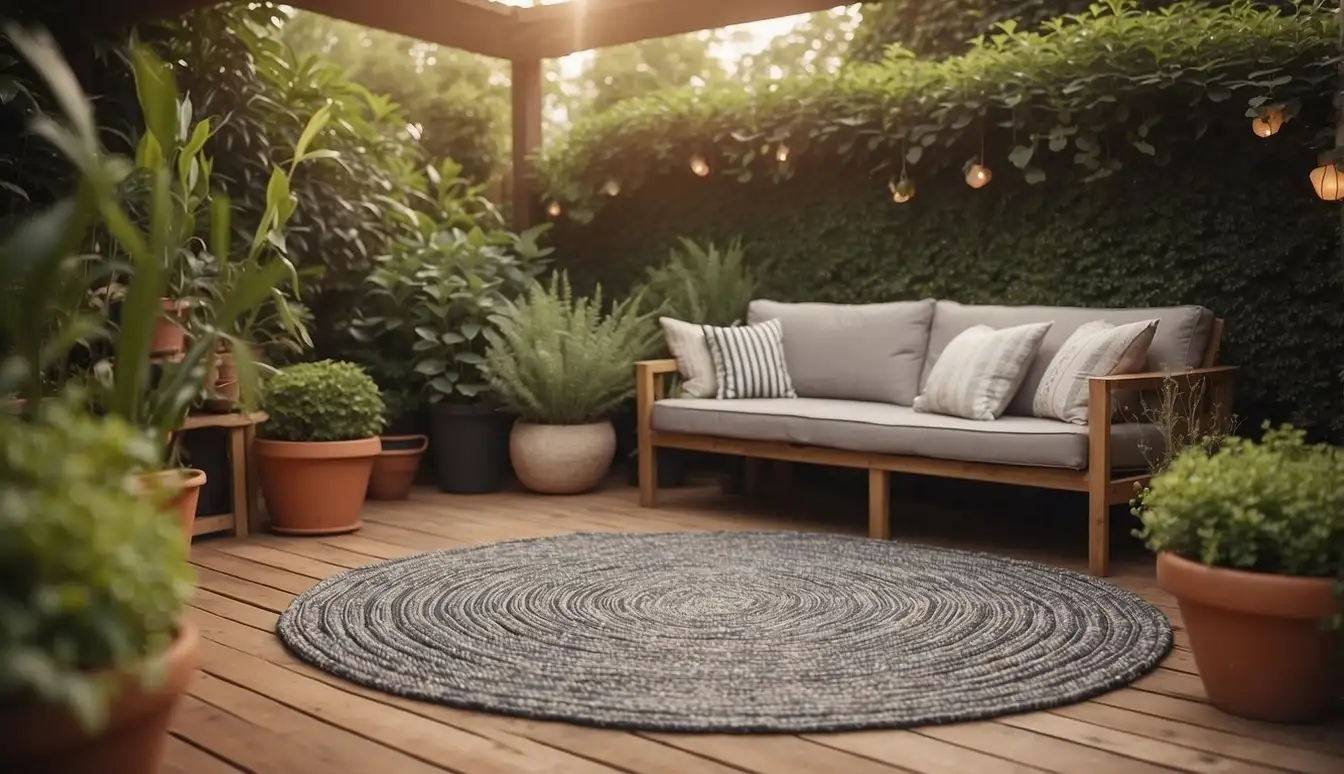
When I’m selecting an outdoor area rug, I consider not just the style and pattern, but also the specific area where it will be placed. It’s important for me to ensure the material and placement are suitable for its intended use, whether that be a sunny patio or a shaded deck.
Area Suitability
For Patios and Decks:Outdoor rugs designed for patios or decks usually need to be made of materials that resist sun fading and moisture damage. I find that synthetic fibers like polypropylene (olefin) or polyester work well in these conditions. Here’s my usual checklist for different surfaces:
- Concrete: Rugs add warmth and can prevent furniture from scratching the surface.
- Tile: I look for non-slip rug options to place on slick tiles, especially around pools.
- Wooden Deck: Choosing a rug that doesn’t trap moisture helps avoid wood rot.
- Grass: Breathable materials are my go-to to prevent damage to the grass underneath.
For High-Traffic Areas:I always select a rug that can withstand lots of movement. Dense weaves and durable materials are key for places where my friends, family, pets, and I frequently gather.
Effects of Traffic and Usage
In my experience, traffic and the intended usage of an outdoor rug largely impact its longevity and how it maintains its appearance. Here’s how I break it down:
High-Traffic:
- Durability: I choose rugs with a tight weave and high resilience.
- Ease of Cleaning: The ability to quickly hose it off or scrub away spills is a priority.
For areas with children and pets, I opt for rugs that are stain-resistant and can handle the energetic play.
Light Traffic:
- Comfort: With softer usage, I can prioritize comfort and choose rugs with a plusher feel.
- Style: I have more freedom to select elaborate designs that might require gentler care.
Whether it’s a stylish patio rug to complement my outdoor furniture or a practical choice for a high-traffic deck area, being mindful of these factors ensures that I find the perfect match for my needs.
Material Selection and Cost
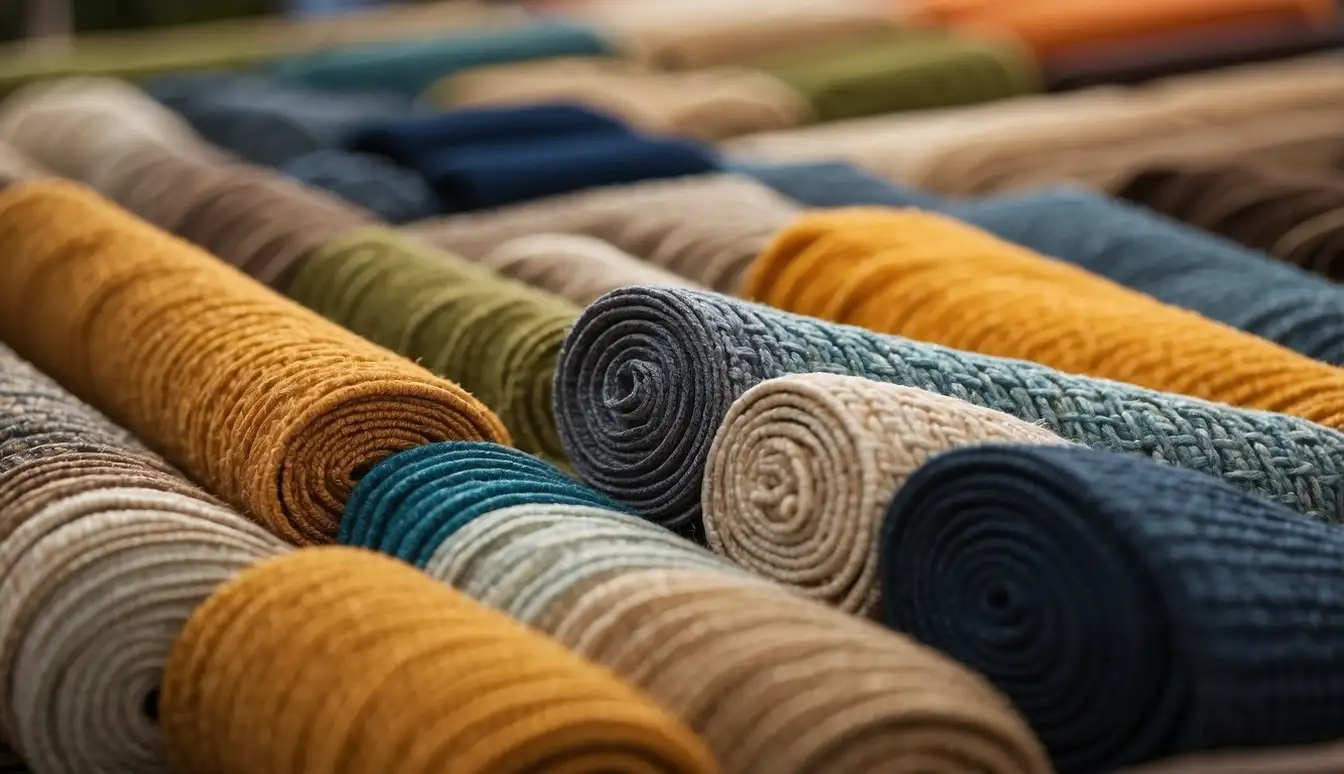
In my quest to find the perfect outdoor area rug, I’ve discovered that material choice greatly influences both the cost and environmental impact. Here’s a breakdown of what I’ve learned about budget-friendly versus premium materials, as well as the eco-friendly options available.
Budget-Friendly vs. Premium Options
When it comes to synthetic materials, polypropylene is a popular budget-friendly option. It’s known for its resistance to moisture, stains, and fading, which makes it an excellent choice for outdoor use. Typically, rugs made from this material are more affordable and provide long-lasting beauty.
On the other hand, nylon is often a component of more premium outdoor rugs due to its strength and elasticity, often blended with other synthetics like olefin for a softer touch. The cost of nylon rugs can be higher, but they offer durability and weather resistance, making them a worthwhile investment for areas with high foot traffic.
Eco-Friendly Materials
For those of us who prioritize the environment, eco-friendly materials like jute and sisal capture my attention as they bring an organic ambiance to outdoor spaces. They’re sustainable and durable but usually more expensive than synthetic rugs.
However, I’m also drawn to rugs made from recycled plastic because they promote environmental sustainability and often come with a more approachable price tag. Eco-friendly materials are not just about being kind to the environment; they also offer functional benefits such as durability and ease of maintenance.
By understanding the intersection of material, cost, and environmental impact, I can make an informed decision that aligns with both my budget and ecological values.
The Lifecycle of Outdoor Rugs
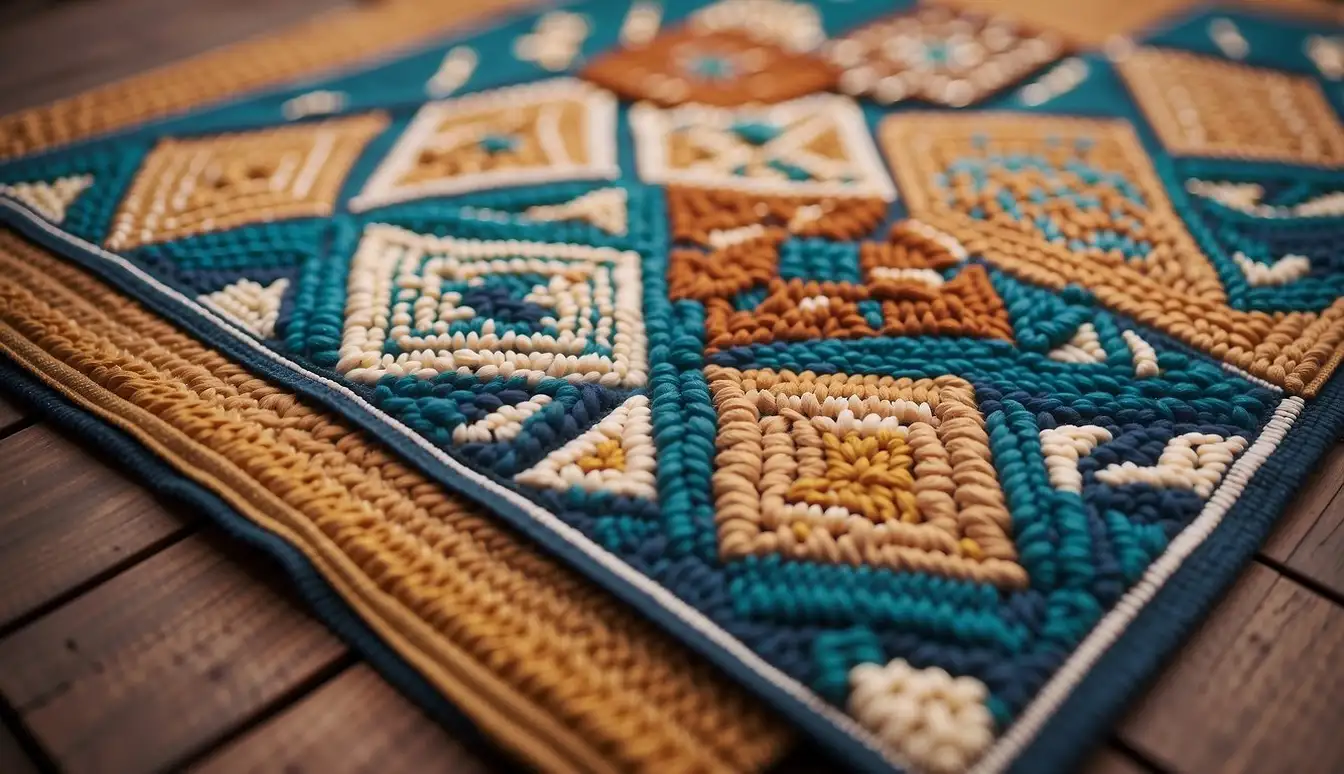
Outdoor rugs play a pivotal role in defining the living space and aesthetic of our outdoor areas. But beyond their visual appeal, I find their lifecycle fascinating—particularly how they stand up to accidental spills and their overall longevity.
Resistance to Spills and Stains
My experience has taught me that outdoor rugs are champions when it comes to resisting unwanted spills and stains. Here’s what you need to know:
-
Materials: The majority of outdoor rugs are crafted from synthetic fibers such as polypropylene and polyester.
- Polypropylene: Notably durable and stain-resistant; repels moisture effectively.
- Polyester: Contributes a softer texture and is also fade-resistant.
-
Maintenance: Caring for these rugs is refreshingly straightforward.
- Cleaning Method: A simple mixture of water and mild detergent will do the trick. Use a sponge or cloth for easy cleaning.
- Drying: They dry quickly, so no need to worry about long wait times after cleaning.
Rug Longevity and Replacement
As for how long these rugs last, it’s all about the material durability and how we maintain them. A breakdown is as follows:
- Durability: Synthetic materials like polypropylene not only resist stains but also stand up to wear and tear, attributing to their long lifespan.
- Replacement: Eventually, even the most durable rugs need replacement. Signs like fraying edges or noticeable wear often indicate it’s time for a new one.
By selecting the right material and keeping up with regular maintenance, I’ve seen outdoor rugs last for several seasons, making them a worthwhile investment for any outdoor space.
Selecting the Correct Outdoor Rug
When I choose an outdoor rug, my focus is on harmonizing aesthetics with functionality to enhance outdoor living spaces while ensuring comfort and safety.
Matching Rugs with Outdoor Decor
The rug’s color, design, and style should complement my outdoor furniture and setting. I consider the existing decor and choose a rug that adds an elegant touch without overwhelming the space. For example, if I have vibrant cushion colors, I might opt for a rug with neutral tones to balance the lively atmosphere.
- Bold Patterns: Ideal for monochromatic furniture, adding visual interest.
- Neutral Colors: Best for enhancing natural elements and not overpowering the area.
Comfort and Safety Features
The material of the rug greatly impacts comfort and safety. A soft and plush rug underfoot can make my outdoor lounge area more inviting. Comfort doesn’t just mean softness; it’s also about the rug’s ability to withstand outdoor elements while maintaining a comfortable texture.
- Polypropylene: Durable, moisture-resistant, and comfortable.
- Polyester: Excellent in Fade and stain resistance; maintains a softness that’s pleasant for bare feet.
- Natural Fibers: While jute adds a beautiful natural look, it requires more care and isn’t as weather-resistant compared to synthetic options.
Ensuring that the rug has a non-slip backing is also vital for safety, especially in areas where children and the elderly frequent.
Frequently Asked Questions
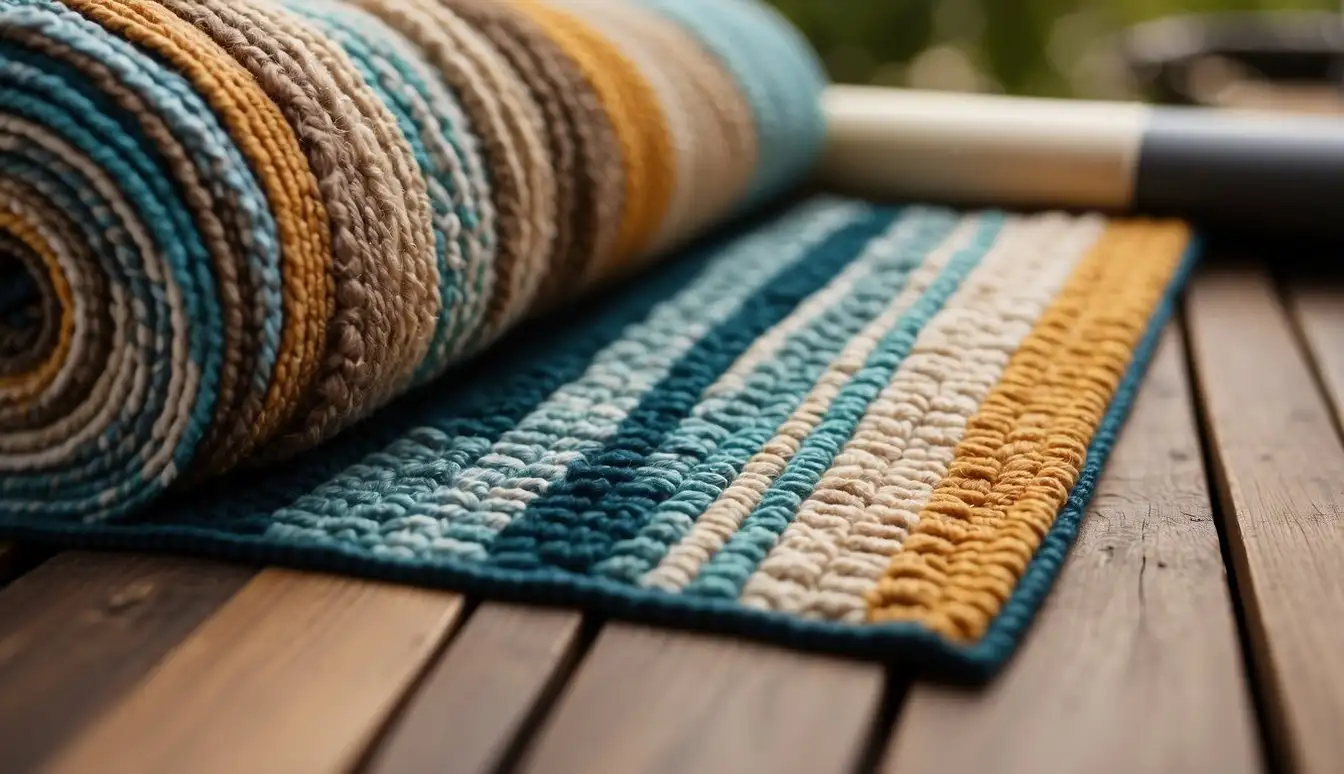
When choosing outdoor area rugs, it’s essential to consider durability, weather resistance, and material sustainability. Here are some common questions to guide you through selecting the right rug for your outdoor space.
What are the most durable materials for outdoor area rugs?
I find that synthetic fibers like polypropylene (also known as olefin) and nylon are top choices for durability. They resist moisture, stains, and wear, making them ideal for high-traffic outdoor areas.
How do I choose the best outdoor rug for rainy weather conditions?
Selecting outdoor rugs made from polypropylene is wise for rainy climates. This material is water-resistant and quick to dry, preventing mold and mildew buildup commonly associated with persistent dampness.
Which is more suitable for outdoor use: polypropylene or polyester rugs?
Polypropylene rugs tend to be more suited for outdoor use due to their strong resistance to moisture and mildew. Polyester also has good fade and stain resistance but may not perform as well as polypropylene in consistently wet conditions.
Are there eco-friendly materials for outdoor rugs?
Absolutely. Natural fibers like jute, sisal, and hemp are eco-friendly options. They’re biodegradable and sourced from sustainable plants. However, they may not be as durable or weather-resistant as synthetic fibers.
Can natural fiber rugs withstand outdoor conditions?
Natural fibers like jute and sisal can be used outdoors, but they require more care. They’re not as resilient as synthetics and should be placed in covered areas to prevent excessive exposure to moisture and direct sunlight.
What qualities should I look for in a waterproof outdoor rug?
A waterproof outdoor rug should be made of materials that repel water and resist mold, like polypropylene. Look for tightly woven rugs, as these typically have less space for water to penetrate and are quicker to dry.
